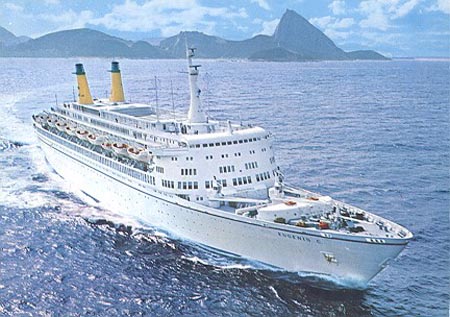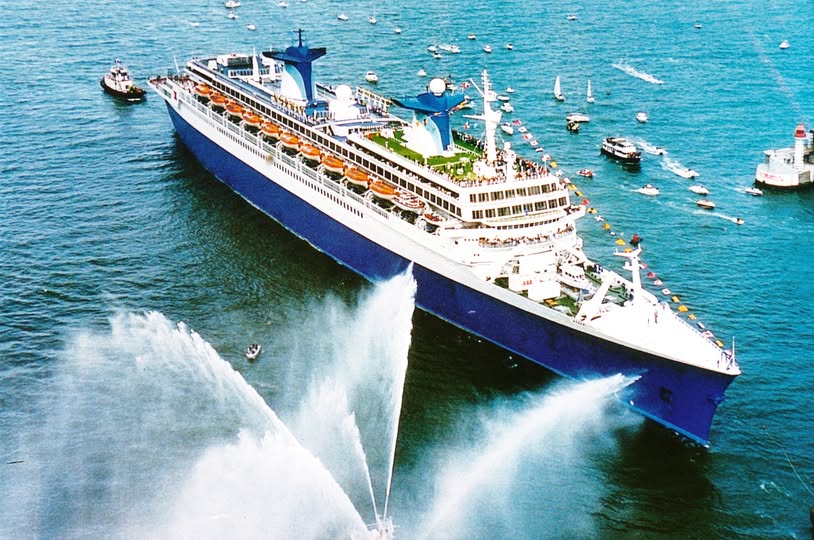In the early sixties Costa Armatori SpA (Linea C) from Genoa, Italy needed a new ship ship for their South American liner service. She needed to be larger and faster than her predecessors to boost capacity. Cantieri Riuniti Dell Adriatico (CRDA) in Monfalcone, Italy built her. The keel laying ceremony took place on January 4, 1964 and the new liner, named Eugenio C was launched on November 21 1964.

In Eugenio C’s public rooms, the best artwork Italy offered at the time could be found, created by Emanuele Luzzati, Enrico Paulucci, Massimo Campigli, and Marcello Mascherini. Finally Zoncada’s sleek, modern furniture and fixtures completed the picture. Her public rooms were mainly situated on the promenade deck. In liner service each class had its own series of lounges and both dining rooms could seat all guests in one seating when cruising.

Giovanni Zoncada had started his career in 1923 when he started working at the Cantieri Navale Triestino of Monfalcone shipyard, becoming one of its directors in later years. He worked on almost every Italian liner during the 1950’s and 1960’s like the Giulio Cesare, Augustus, Andrea Doria, Cristoforo Colombo, Leonardo da Vinci, Michelangelo, and Raffaello. Also, he designed all Costa vessels up to the Carla C in 1968.
Naval architect Costanzi is known for the “duck tail” he had patented, a stern design which he used for both Eugenio C and Oceanic (also built by CRDA for Home Lines, she became their flagship in 1965) two of his most famous designs. This stern design, later adopted by many modern cruise ships, pushes the water flooding along the sides of the vessel apart so it meets further aft of the vessel resulting in less drag and thus fuel efficiency and higher speed as well as improved stability aft.
An early shipyard fire caused some minor damage, but it was quickly extinguished and Eugenio C was launched on 21 November 1964 by the wife of Costa Lines’ president, Angelo Costa, Pinuccia Costa.

After having been delivered to Linea C on August 22, 1966, Eugenio C departed for her maiden Trans-Atlantic voyage from Genoa to Buenos Aires. Being powered by two CRDA De Laval turbines producing 60,000 hp she reached a top speed of 28.5 knots during sea trials. With her average service speed of 27 knots on the South Atlantic run she shortened the crossing time considerably. It was never surpassed by any passenger vessel.

The magnificent new 230 meter long, 30,000GRT liner had capacity for 214 first class passengers and 1445 tourist class.

Her splendid interiors, high speed and attractive profile (she was one of the last ships having sheer) made her the ultimate ship sailing on the Europe – South America service. Hamburg Sud’s sextet of Cap-San class combi liners, better known as the Swans were luxuriously appointed ships, but they carried just 12 passengers, so Eugenio C did not really have any serious competition during her early years. For the next decade, sailing in transatlantic service form Genoa to South America, all went well, she was a very popular ship. But then, in the late seventies, like on every liner service worldwide, passenger loads plummeted and starting 1977 Costa placed her more and more in cruise service. In the mid-eighties she only crossed the Atlantic during a repositioning voyage.

In 1987 Eugenio C was renamed Eugenio Costa and she was completely overhauled and upgraded. During this USD $25 million upgrade at the T Mariotti shipyard in Genoa she was fitted with a new showroom (which according to some spoiled her profile aft) and received several modifications to her public areas and accommodation.

She remained a popular cruise ship but in the 1990’s, now an older vessel, Costa planned to transfer her to American Family Cruises (part of the Costa Group) renaming her American Pioneer. This new venture never really left the drawing boards however, exisiting just for a couple of months, but Costa Cruises still felt she had become too old and inefficient to operate being one of the last steamships in service.
She was quickly sold to the Bremer Vulkan shipyard and chartered back to Costa until November 1996 when she completed her last cruise. She was part of the payment for their newbuilding Costa Victoria. Eugenio Costa was laid up at Genoa for the time being.
However, Bremer Vulkan went bankrupt soon afterwards and she passed into new ownership again when she was acquired by British shipyard Cammell Laird. They immediately chartered her to Lowline Shipping who in turn chartered her to Direct Cruises. Lowline/ Direct Cruises acquired her outright in 1998.

Direct Cruises was an UK-operator of budget cruises marketed through telephone sales. Renamed Edinburgh Castle, she was refitted for US$12 million. But although much needed maintenance had now been done, she still suffered from an ongoing series of technical problems. Amongst other problems her boilers were very troublesome at this time. This caused Lowline/ Direct Cruises to go bankrupt in 1999 already. Edinburgh Castle was now owned again by Cammell Laird, Direct Cruises main creditor.


They now chartered her to Premier Cruises, a small US-cruise line which only operated classic ships. Premier had her thoroughly refitted and upgraded which took close to a year. She was renamed Big Red Boat II and emerged with a bright red hull like the other Premier vessels except their Rembrandt (fans of Holland America’s former Rotterdam of 1959 strongly objected). She entered service in 2000, but after just four months Premier Cruises went bankrupt and ceased trading. Keeping their fleet of old passenger ships, former liners needing extensive maintenance and being extremely costly to operate had taken its toll on the company’s financial reserves.
She was returned to her owners Cammell Laird which tried to find new employment for the ageing ship, but apart from a short charter to the US government they were not successful. So Big Red Boat II was laid up at Freeport together with several of her Premier fleetmates like the Big red Boat III (former S.A. Vaal) and the majestic Rembrandt, which has since been completely refurbished and is now open in her former homeport Rotterdam Holland as the successful SS Rotterdam hotel and tourist centre since 2010.

The Big Red Boat II was placed on the market along with the other Premier Cruises vessels. Her interiors were still immaculate, but during the final years of her career she had developed a rather bad reputation concerning her machinery and boilers which once again needed extensive maintenance and repairs. It was hard to find an interesting party, but finally the Big Red Boat II was sold to Argo Ship Management in 2003. Sadly, they didn’t do anything with the ship and she was left in situ to deteriorate.
She was still offered sail or charter but over time it became clear that she would never see active service again. Her troublesome engines were considered too much of a risk and apart from that, she was one of the final steamships in existence meaning that she would be very costly to operate compared to a diesel fuelled motor ship. So she remained in Freeport for five years, silent and forgotten.

Then it was decided she would go for scrap. She was sold to Indian breakers in 2005 and this once mighty liner left Freeport as Big Red under her own power. Miraculously, her delivery crew had succeeded in firing to fire up her boilers once again for her last voyage and belching out huge clouds of smoke, she crawled to the Azores where she docked for bunkering mid April. She then headed for Alang where she was beached on June 5, 2005. Because of her deep draft of 8,5 m and the fact that nearly had nearly lost all power of her once mighty engines, the former Eugenio C beached far from the breaker’s beach, making the dismantling process significantly more time consuming and costly. In late 2005 this scrapyard was being investigated by Indian courts for safety and environmental violations which delayed scrapping this former speed queen of the South-American run even more.


